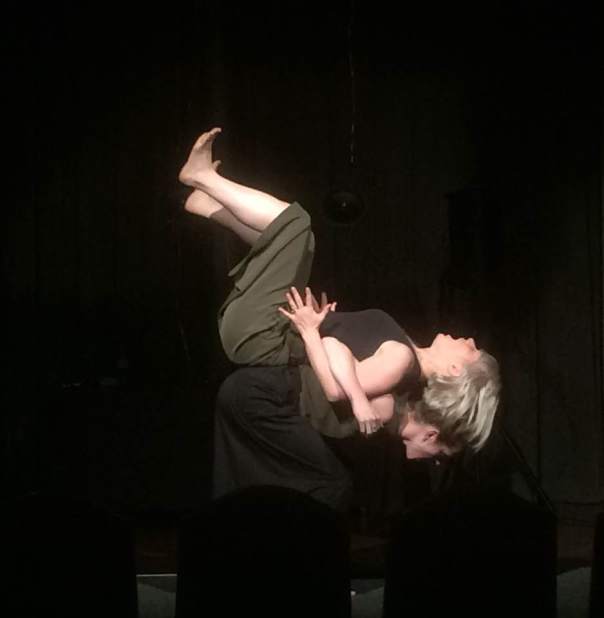
Review by Simone Maurer
Dressed in loose-fitting black and khaki clothes, Jessica Aszodi and Jenna Lyle began Grafter centre stage, facing each other. The stage was equipped with microphones, hanging speakers, and electronic equipment on a desk. Standing motionless, Aszodi sang a sustained vowel-tone as Lyle swayed her upper body over Aszodi, purposely interrupting her vocal projection. This example of what the performers describe as “choreographically affecting sound” underpins the work, and highlights the use of body movements for sound effect, rather than visual effect. The performers’ body movements were not intended as a separate artistic element—they were integral to the sound production. In fact, there was little movement which was not connected to a sound. Dividing the performance between acoustic and electronic production, Aszodi and Lyle used “gross and fine body movements” to interplay and interact with elements of vocal production, resonance, space, and electronics.
Although one uninterrupted work, I heard the performance as a book of etudes; each study seemingly designed to focus on a particular element. The focus of the first etude, choreographed sound manipulation, was developed in the following etude to interplay with the resonance of the performer’s bodies. Still facing one another, Lyle swayed and weaved around Aszodi’s open mouth, sporadically capturing its resonance as they sang. Lyle introduced a microtonal interval, producing a combination tone which created further aural distortion. This ‘third voice’ was perhaps a reference to the later electronic voice of feedback produced by two other bodies (microphone and speaker). The specific relationship between Aszodi’s and Lyle’s bodies allowed them to produce a unique set of sounds and movements, and it is hard to imagine the work being as successfully focussed if performed by substantially different bodies. For example, if a great height difference meant Lyle had to stand on tiptoes to reach Aszodi’s mouth, or if one performer was male.
The third etude introduced larger body movements and hinted at the upcoming electronic elements. Sound exchanges between long syllables, shushes, and hisses—accompanied by pulling and pumping of the performers’ arms—evoked imagery of piston-like forces and motions within a mechanical machine. The athletic spectacle of the work increased dramatically as Aszodi and Lyle linked arms behind their bodies and, in turn, lifted the other onto their back. This was a display of both physical and vocal strength, which left me wondering what it would be like to experience another vocally resonating body on mine as I either lifted or was lifted. Although these movements were interpreted by some as comedic, I saw the combination of strength and risk as one of the more physically intense moments of the performance. The slight bodily trembling and hesitance momentarily drew the performers’ experience to the foreground of the performance.
The second, shorter, part of the performance explored interaction between body, space, and electronics, specifically the two hanging speakers, microphones, and hand-held lights. Choreographically manipulating sounds from the speakers, Aszodi diverted the white noise around her flowing body movements. Lyle soon joined, mirroring Aszodi’s movements, while holding small lights. I am not sure if the lights had a deeper meaning, but their presence prompted interplay between both visual and aural ‘shadowing’. Later, the lights were rubbed over the live microphones, creating the perception of an ostinato.
The final etude explored interplay between human versus electronically produced whistles, and the handheld lights were now less of a visual influence. Aszodi’s soft whistles were accompanied by slow pacing across the stage; however, not moving may have better complimented Lyle’s still body, which only moved to rub a live microphone on a speaker, producing short, delicate pitches of feedback. The gradual dimming of the lights and human/electronic whistle interplay clearly signposted the closure of the performance. The first light went out. Aszodi’s whistling ceased. The second light went out. The feedback whistle stopped. Silence.
As a performer-researcher interested in the fields of musical gesture and embodiment, I found Grafter to be an informative study of some possibilities of choreographed sound manipulation. Live electronics is a performance element I am not experienced or knowledgeable in; however, Grafter has prompted me to investigate incorporation of electro-acoustic elements into my flute playing. I have greater confidence in pursuing this after attending the BIFEM Composer Colloquium, which was presented the day following Grafter. Chaired by Aszodi, both she and Lyle discussed their work and development as multi-disciplinary artists. Aszodi voiced her concern, held by other audience members (myself included), of being boxed in to the label of one discipline, such as ‘Singer’, ‘Composer’, or ‘Dancer’. She spoke of the difficultly in trying to include other artistic elements outside her label as ‘Singer’, which the panel (also consisting of Eliot Gyger and Matthew Horsely) attributed to concepts of authority and expertise. They agreed that expertise in an artistic discipline was achieved through formal accreditation and years of practise. However, Aszodi argued that rigorously committing to a secondary artform is possible—as she is currently doing with her dance education. Aszodi’s artistic ‘identity crisis’ resonated with my own as I am also beginning study in dance and struggle with feeling like an imposter. I think that Aszodi’s and Lyle’s combined expertise and knowledge of singing, dance, and composition strengthened and informed their performance. As Grafter is a continually evolving work, I hope to witness future adaptions by Aszodi and Lyle, resulting from their further interdisciplinary exploration.
Grafter
Jessica Aszodi and Jenna Lyle
Bendigo Bank Theatre
Bendigo International Festival of Exploratory Music
1 September, 2017